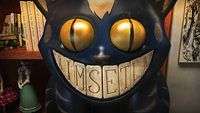Gray Matter – Review
by Lorna
|
 Gray Matter is another of those games which has slipped the bonds of a protracted development and finally escaped to see a release. While it may be a genre away from Alan Wake and Duke Nukem, Gray Matter’s history has been no less painful, bouncing between developers and publishers before finding itself in the hands of Wizarbox and Lace Mamba. It is (unfortunately) a rare exception of the genre that has actually pricked mainstream attention, largely due to the nostalgic expectations attached to the game’s writer, Jane Jensen – famous for her narrative skill and creation of one of the adventure genre’s bedrock series, Gabriel Knight.
Gray Matter is another of those games which has slipped the bonds of a protracted development and finally escaped to see a release. While it may be a genre away from Alan Wake and Duke Nukem, Gray Matter’s history has been no less painful, bouncing between developers and publishers before finding itself in the hands of Wizarbox and Lace Mamba. It is (unfortunately) a rare exception of the genre that has actually pricked mainstream attention, largely due to the nostalgic expectations attached to the game’s writer, Jane Jensen – famous for her narrative skill and creation of one of the adventure genre’s bedrock series, Gabriel Knight.
Gray Matter is a 2.5D point and click mystery spanning eight chapters and is largely set in and around Oxford. We come on the scene just as Sam Everett, a street magician, gets lost and breaks down on her way to London where she was to try and gain entry to the famous Daedalus Club. It is, in the best mystery traditions, a wet stormy night, and she takes shelter at Dread Hill House posing as the new assistant for Neurobiologist Dr David Styles. Styles, once a respected and famous doctor, has become a recluse since the tragic death of his wife Laura and rarely leaves his large mansion, preferring instead to conduct his own personal experiments in his basement labs. After weighing her options, Sam opts to stay and maintain her charade until she can repair her dilapidated bike and sets to work rounding up test subjects for the grumpy doctor. What starts out as a number of seemingly harmless experiments into the ability to derive benefit from exercise with mere imagination soon turns into something decidedly more alarming, with a series of bizarre and unexplained events stalking each experiment.
While Sam sets out to unravel the mystery, Styles has his own issues to deal with as his dead wife seems to be making her presence felt once more at Dread Hill. As part of his own experiments, Styles, desperate to hang onto his beloved wife, has been using his research into the mysteries of the human brain to try and focus his energies on Laura to help give her the ability to manifest in some form. With the odd events both in and around Dread Hill House, he begins to believe he has been succeeding and redoubles his efforts. Sam in the meantime is convinced the whole thing is a sham, designed as either a cruel prank by jealous colleagues to discredit and torment the lonely recluse or is otherwise a ‘Big Game’ being orchestrated by a master magician seeking their own entry to the Daedalus Club, and is determined to put a stop to it. The story, as it twines together these various strands, manages to juggle three balls until the closing scenes – those of supernatural, science, and illusion, and it is never certain which way they will eventually fall, the potential being there to genuinely be any one or more of them.
One of the game’s greatest strengths is the ability to play as both David and Sam in (mostly) alternating chapters. This mechanic allows the player to sink further into the narrative with the benefit of a different set of eyes, motives, and understanding that offers a welcome level of depth and balance which would otherwise have been missing. The two characters are in direct contrast to one another: Sam is an ex-goth with sexy dress sense, who has been working as a street magician, hoping to eventually gain entry to the secretive Daedalus Club – a dark home to the most talented magicians in the world. She believes in what she can see and hear, and that there’s nothing which can’t be explained in the form of an elaborate ruse; this attitude sets the tone of her side of the story. She is hard, ballsy, and smart, though her tough life has left her mistrustful and genuinely surprised by any act of kindness.
Styles, on the other hand, was born into wealth and was a leading neurobiologist with some controversial theories on the untapped potential of the human brain and the possibilities it could point to. His theories led to some professional and personal derision from others, but he was flying high until the accident which claimed the life of his wife and left him wearing a half face mask to hide his disfigurement. He subsequently closed his clinic and retracted from the outside world, becoming obsessed with the memory of his wife. David Styles is troubled, moody, and impatient, even unpleasant on the face of it, but we see beneath the abrasive personality to the lonely, haunted man, tortured by the absence of the woman who was his whole world and this gives his story more of an emotional anchor. Overall, the characters are compelling and likeable, despite their flaws, and I genuinely cared about their fate.
In perfect compliment to the wildly different characters, the chapters that they dominate mirror their personalities. Sam’s are more dynamic, extrovert, inquisitive affairs as she runs all over Oxford leaping to conclusions, seeking clues, asking questions and generally tricking and manipulating her way into everything. In addition, she is tasked with solving a number of elaborate riddles to try and snare an invitation to the Daedalus Club. David’s chapters take a far more sedate pace. Full of nostalgia and melancholy, he drifts through his days, absorbing and recalling memories, losing himself in hallowed, precious moments with Laura and trying to build enough sensory fingerprints to aid his intense visualisation exercises. David’s scenes contain the most flashbacks, as we glimpse his happy, former life and the man he was, compared to the curmudgeonly, mournful shell that he has become.
The contrast between the two is a welcome relief and allows for a distinct grinding down of gears at just the right moments. While Sam’s chapters are more puzzle intensive and therefore feel more ‘action packed’, I honestly preferred David’s – though there are many who will undoubtedly feel that they slow down the pace too much or cause everything to drag. With few NPCs in sight, I found exploring David’s melancholy infused life sad, but oddly fascinating. These chapters may be a lull for the more impatient gamer, or those who like simply charging through an adventure, manipulating inventory items like a juggling squid, but they are important in laying the emotional foundations of the story; not only that but they help explain David’s motivations and lend the character a sympathetic slant.
 David’s chapters are relatively puzzle-lite compared to Sam’s, preferring instead to let the player explore and absorb while jogging the story along and throwing up more sand to fog the ultimate outcome to the game’s puzzling events. Running through Gray Matter, along with a number of literary themes, are strains of loneliness, helpless frustration, guilt, the power of the human mind, and isolation. In her way, the confident Sam is just as shut-off as David, just in a different way, finding an unexplored kinship in their similar grief.
David’s chapters are relatively puzzle-lite compared to Sam’s, preferring instead to let the player explore and absorb while jogging the story along and throwing up more sand to fog the ultimate outcome to the game’s puzzling events. Running through Gray Matter, along with a number of literary themes, are strains of loneliness, helpless frustration, guilt, the power of the human mind, and isolation. In her way, the confident Sam is just as shut-off as David, just in a different way, finding an unexplored kinship in their similar grief.
Gray Matter’s interface stays largely true to most of its modern point ‘n’ click kin by keeping the screen blissfully uncluttered. Everything of use is restricted to the top of the screen where a swift mouse-over reveals the inventory and buttons needed to access the menu, progress bars, and map – also accessible via keyboard shortcuts. While these things only really see subtle changes from game to game, Gray Matter’s handling of the inventory is a touch frustrating, with the player required to first load an item into Sam’s hand before she uses it. Items such as keys and ID cards requiring repeated use don’t automatically get used and have to be located and loaded every time which is a pain, especially in the Xbox360 version – more of which later.
The map is a convenient fast travel device and the only way to nip between the location clusters, but it also acts as an indicator of where you may have missed tasks or bonus points. Your progress throughout each chapter is broken down into puzzle sets and presented as a number of progress bars for each one; the tasks and interactions to complete these can be tackled (for the most part) in any order. Bonus points can be gathered from a variety of trivial things from chattering to certain NPCS to interacting with most objects in a location, but they are optional and easy to miss if you aren’t the sort to test all hotspots to destruction.
 |
 |
 |
 |
 |
 |
 |
 |
 |
Hotspots representing objects to be interacted with come in several flavours, depending on whether you can use, look at, or talk to them and, as has blissfully become a genre staple, can all be toggled on and off at the press of a button. In a surprising move, perhaps demonstrating an eye on a slightly more mainstream audience of adventure virgins or returning drifters, the game’s map has made things easier by colour-coding the location titles depending on what, if anything, you still have to do there – bonus points, primary tasks, etc. This is welcome in that is does reduce backtracking and mooching around when stuck, but it risks opening itself up to accusations of dumbing down from the more diehard or masochistic aficionados.
The number of locations is actually surprisingly small and, as such, the game feels deceptive in its real size. Although there are great in-game places reflecting the real Oxford cityscape such as the Bodleian Library and Christ Church College, some consist of little more than a lone screen. While this seemingly compact size suits the intimate feel of the game, and isn’t an uncommon adventure occurrence, it was a touch disappointing – I suppose I expected a little more breadth given that Gray Matter appeared to be a bigger release with more fanfare and interest than most adventures are afforded. It was mainly a let down from the point of view that the locations were so well realised – of course I wanted more.
 The graphics are beautiful, with each location presented in absorbing detail and colour, down to trivia such as graffiti scrawled on walls and rooftops to shelves and offices full of bric-a-brac. The environments are true to the 2.5D formula with the characters being fully 3D; David and Sam are especially well presented and detailed, down to Sam’s eye catching boob tattoo. What did jar visually, however, was the subtitle bars – they threw up a rather sinister 3D talking head which looked as if it had been inflated with a bicycle pump. As disconcerting as these were, they could be switched off in the options, though I wouldn’t recommend this for those playing the Xbox version, since there are some sound balance issues.
The graphics are beautiful, with each location presented in absorbing detail and colour, down to trivia such as graffiti scrawled on walls and rooftops to shelves and offices full of bric-a-brac. The environments are true to the 2.5D formula with the characters being fully 3D; David and Sam are especially well presented and detailed, down to Sam’s eye catching boob tattoo. What did jar visually, however, was the subtitle bars – they threw up a rather sinister 3D talking head which looked as if it had been inflated with a bicycle pump. As disconcerting as these were, they could be switched off in the options, though I wouldn’t recommend this for those playing the Xbox version, since there are some sound balance issues.
The game’s cut-scenes have been the subject of some online debate, given that they are wildly different from the in-game art style. They take the form of frozen hand-painted, almost ‘anime style’ montages, with a pan and zoom, linger and cut dynamic. It is purely a matter of taste, but I’ll shrug and hold a lazy middle finger up to the critics and say that I genuinely enjoyed them a great deal. Whether the developers opted for this style purely for aesthetic purposes or there were underlying budgetary concerns, I don’t know, but it didn’t phase me. The contrast was a welcome one and the art was well presented and suited the, often, emotional scenes and haunting music. What I did find mildly irksome with however, was the fact that the cut-scene David was far more dashing than his dour, often dowdy in-game counterpart – though his taste in coats remains second to none, regardless.
Overlaying the game and, in particular the cut-scenes, is a beautiful score which includes a number of vocal tracks by real life band The Scarlet Furies. The soundtrack is comprised of a number of haunting, goth/folk style songs and pieces, infused with a gentle melancholy which compliments the difficult lives of both protagonists and helps to enrich the journey through David’s memories in particular.
As far as the game’s puzzles go, they are not overly taxing and won’t take long to overcome. They range from the usual inventory based puzzles to setting up RNG machines, tracking down sensory items for an experiment, and conning your way into various locations. Not willing to pass up the opportunities afforded by a magician character, the game introduces what is, on the face of it, an innovative puzzle mechanic. In Sam’s possession is a book of childhood magic tricks which can be adapted and employed to overcome a variety of in-game problems. Using one takes you into a screen where Sam awaits like a slightly tired Vitruvian Man, ready for you to select a number of actions which have to be queued in sequence in order to successfully pull off the required trick. This is great in theory, but sadly falls down in practice, since the game is especially pedantic about being exactly on the money. Perform the correct actions but starting with the wrong hand and you’ll be starting over. Why? Because it says so. What’s the difference? None. Mostly, you’ll have the magic book open and it is just a question of copying the list of actions verbatim, as dictated by the trick page, with no leeway for creative freeform/interpretation and this on-rails interaction leaves you with odd by-the-numbers moments which don’t offer any kooky or entertaining cut scenes as a reward and as such it feels like a wasted opportunity, although the idea was a sound one.
 While many of the puzzles and interactions were smart, others were oddly easy, with some items appearing right beside the person or problem in question – the most ridiculous perhaps being a puzzle box – needing water to activate it – being found in an actual fountain. Often the game would frustrate by refusing to jog along until you hit some unknowable trigger and some puzzles could be a little vague. I had no idea for instance that I should use the cell-phone to call a character’s mother, or ring another that I’d spent over an hour searching for (and trying to trigger a cut scene to reach). Other snag points included a fuse box related puzzle that was oddly annoying given that I knew exactly what I had to do and how to do it if the game would just let me.
While many of the puzzles and interactions were smart, others were oddly easy, with some items appearing right beside the person or problem in question – the most ridiculous perhaps being a puzzle box – needing water to activate it – being found in an actual fountain. Often the game would frustrate by refusing to jog along until you hit some unknowable trigger and some puzzles could be a little vague. I had no idea for instance that I should use the cell-phone to call a character’s mother, or ring another that I’d spent over an hour searching for (and trying to trigger a cut scene to reach). Other snag points included a fuse box related puzzle that was oddly annoying given that I knew exactly what I had to do and how to do it if the game would just let me.
While these things were irritating and disrupted the pace, it was never to the point of wanting to abandon the story. And the story is very much where it all is with Gray Matter. Some adventures are just a thin skin of generic story stretched to breaking point over a bulging sack of puzzles until you can almost see through it. Gray Matter on the other hand, offers a blissful depth with many layers, dead ends, red herrings, and intriguing backgrounds to keep the player immersed until the final reveal.
As with many narrative driven games, there are usually weak spots and all too often these occur at and risk derailing the ending. While Gray Matter’s end didn’t exactly disappoint, I wasn’t overly satisfied either; the big reveal was doled out in the last few cut scenes and was surprising, delivering a blend between disappointingly normal and bizarre (or hypernatural for want of a better term) and not something that the player could have necessarily foreseen. That said, there were several tantalising supernatural threads left hanging amid some unexplained events, which lent a more satisfying and open touch to the outcome and raised some interesting hopes for a sequel.
 A number of potentially fruitful paths were left unexplored; the professional rivalry between David and Linkweller for example felt truncated and underused, serving only as a disappointing red herring among the many on offer. The separate elements of the Daedalus Club and Sam’s quest for membership however were an interesting diversion and allowed some creative and outlandish locations to be thrown in when she reaches this opulent den of illusionists. The puzzles here are smart but never taxing, though one has to wonder what contractor they hired to install a swamp in their extensive basement network.
A number of potentially fruitful paths were left unexplored; the professional rivalry between David and Linkweller for example felt truncated and underused, serving only as a disappointing red herring among the many on offer. The separate elements of the Daedalus Club and Sam’s quest for membership however were an interesting diversion and allowed some creative and outlandish locations to be thrown in when she reaches this opulent den of illusionists. The puzzles here are smart but never taxing, though one has to wonder what contractor they hired to install a swamp in their extensive basement network.
Gray Matter has been a long time in the making and, now it’s here, it doesn’t disappoint much. While there are frustrations with scene triggers, some questionable puzzles, technical issues with some animations, and some odd inclusions such as the near-useless diary, it succeeds more than it fails. Gray Matter presents a well written, absorbing story with a depth which should be the envy of many and the study of more, both in the adventure genre and mainstream at large. While the ending can be viewed as something of a sharp direction change, and therefore a let down, there were enough tiny threads left hanging to salvage it.
The characters are well realised and play out their roles against some beautiful backdrops and (mostly) satisfying NPC foils and the dramatic cut-scenes were enjoyable, if somewhat controversial. The superb score was a standout not often seen in games of this nature, but for me it was the story and characters that made it a success. The twin protagonist system gave the game balance and a depth, allowing the story and characters to develop and shine, which, to me, is the most important aspect.
 |
 |
 |
 |
 |
 |
 |
 |
 |
Xbox360 version
 The Xbox360 version of Gray Matter was always going to be interesting, hamstrung from the start by the nature of this type of game. In recent times we have seen point and clicks released or rebooted on the console, so there is no real reason why Gray Matter can’t succeed, is there? Yes and no. The game is identical – the story, characters, and animations are the same and although the Xbox can’t compete graphically with the PC version, it puts up a very respectable fight. Map and progress bars have been mapped to various buttons and bumpers and feel very natural, although the interaction is where everything sticks.
The Xbox360 version of Gray Matter was always going to be interesting, hamstrung from the start by the nature of this type of game. In recent times we have seen point and clicks released or rebooted on the console, so there is no real reason why Gray Matter can’t succeed, is there? Yes and no. The game is identical – the story, characters, and animations are the same and although the Xbox can’t compete graphically with the PC version, it puts up a very respectable fight. Map and progress bars have been mapped to various buttons and bumpers and feel very natural, although the interaction is where everything sticks.
Rather than simply moving the pointer over the screen, RT pulls up a wheel which highlights hotspots and allows you to interact with them. Nudge the thumbstick and press A and you’ll select the item/person and kick off the desired interaction. In theory. In reality it can be a frustratingly skittish affair, with the thumbstick swinging wildly past your elusive target. Unless the player has the hotspots almost permanently enabled, it would be very easy to miss objects using this method alone. To get around the problem of selection, I discovered that the stoic D-pad offered a much more sensible approach and when combined with the thumbstick to land me in the general area, I began to make progress. Sound is also something of an issue; during the cut scenes the music cranks up to the point that it drowns out the dialogue, leaving you reliant on subtitles.
Aside from scooping achievements, there is no real difference, aside from those stated, and if you aren’t phased by the interaction issues, then the Xbox is a fair choice. Mouse aficionados and the more graphically conscious will be better off sticking to the PC version, especially as the loading screens beat the Xbox hands down. And you’ll be seeing a lot of those.
Pros- Well written story and absorbing characters
- Lovely soundtrack with some great vocal tracks
- Beautiful locations
- Dual protagonists allowed for a real depth to emerge for the characters and backstory
- Enjoyable and refreshing cut-scene animations
- Various elements such as science, supernatural, and illusion made for some intriguing possibilities
- Sequel please
- No way of seeing overall progress to check bonus points and no reward for getting them all regardless
- Scene triggers can be frustratingly obtuse at times
- Some technical issues with character animations
- Ending didn't satisfy as much as it could have
- Magic 'by numbers' felt like a wasted opportunity
While not without its flaws, Gray Matter stands out in its genre and, indeed, above many mainstream titles as an absorbing, well-written game with a real depth to be found in its compelling characters and narrative. The dual protagonist gameplay allows the player to sink into both Sam and David’s worlds, serving to flesh them out to a degree that was very satisfying. A beautiful soundtrack boasts a number of vocal pieces which, along with the beautiful, often creative, locations created a haunting tale exploring supernatural, magical, and scientific possibilities. The human themes are where the real heart lies however, with Sam and David sharing similar tragic parallels while being outwardly very different and themes of isolation, guilt, grief, and loneliness all weave through the tale, along with, most importantly, hope.
The ending felt slightly dissatisfying and some unanswered questions remain, although these were largely in the form of some pleasantly intriguing supernatural threads which leave the game poised for a sequel. Despite some frustrations with scene triggering, interactions, and some sadly flat trick elements, Gray Matter is a solid, beautiful adventure that, while not wall to wall with puzzles, finds a good balance while making the characters and story the soul of the piece.
Last five articles by Lorna
- Flagging Heart
- Where Have All the Hours Gone?
- I Heart... Overlord
- Life Goes On: Done to Death - Review
- Welcome to Spoilerville, Please Despise Your Stay

























Amazing review, and it’s a lot of dedication to play through the game on both PC and Xbox.
Sounds like a game I’d actually be quite interested in, though it’s a shame the story doesn’t end satisfyingly, as these sort of games I play pretty much nearly entirely for story. Still, hope it does well and overcomes the difficulties it faced before released
Thanks Ed, it was worth the repeated plays. Very enjoyable game. The ending was odd because part of me was fine but I think my feeling stemmed from expecting something else and it ended up with me thinking “Oh. Really? Oh, okay then, but…ok. Fair enough. Sequel please.” Then I started to comb through everything that wasn’t explained and noted some of the intriguing supernatural stuff left dangling and felt much better Very good story for this type of game, so I heartily recommend it
Very good story for this type of game, so I heartily recommend it 
Let me start by saying what a hottie that girl Sam is… from her clothes to her saunter, she comes across on screen as a very sensual woman that has more than card tricks up her sleeve. But anyway… having watched Gray Matter being played through twice, I’d say that the XBox version is pretty faithful to the PC release but I’d definitely opt for the PC version to take advantage of the more intuitive controls and enjoy the stunning visuals.
The voice acting was better than expected, and I thought it was a great touch to have a full soundtrack by a single artist throughout the game, rather than a composed score. It may have been done before, but I’ve not come across it on my travels thus far, and that aspect certainly appealed to me. Have to agree on the dialogue balance though; had it not been for the subtitles on the XBox version, I wouldn’t have known what was being said at times as the music and effects were considerably higher than the voice audio.
I’m about to finish one game myself and, rather than move on to Gothic IV next, I think I’ll take a step away from the lengthy RPGs and try a few point ‘n’ clicks first, so this will be my first. Nothing to do with the hottie though, honest guvnor!
Fantastic screenies by the way!!
Sold! I shall be picking up a copy for the xbox as soon as payday hits
[...] This post was mentioned on Twitter by Edward Price and Lorna Reid, GamingLives. GamingLives said: Today on gaminglives Lorna Reviews mystery adventure game Grey Matter http://gliv.es/hYAmkM [...]
Great review Lorna, I liked that the story is told from a dual perspective. Kinda reminds me of the Broken Sword games where you would take turns being either George or Nico. The visuals look fantastic on this game too but I’m not too sure about the style of the cut scenes but then again I’ve not witnessed them first hand so I will reserve judgement until I’ve played it.
Not a day one purchase for me but as I have fond memories of Broken Sword, and this reminds me alot of that game, I think I might pick it up if its going cheap in the next Steam sale.
Great review! I look forward to playing this at some point.
Visuals in this look absolutely stunning. Interesting to see how the game fares on the Xbox 360, not sure I can recall too many point and clicks on there.
Great review! It’s a game I’ll def give a go once my single player backlog has cleared a little. Estimate – 2014
I was sold on this some time ago, right until it came to finding the money for it. Now that Two Worlds II is emphatically off my wishlist though I think I’ll see about getting this. Might even try to import the German special edition, since we’re getting screwed on that score here in the UK.
Great review as always L, confirms a lot of what I was hoping about with this game, and it’s nice to see that the niggles are in the minority. Considering that your last recommendation is proving to be a lot of fun too (Edna and Harvey, of course), having you say that this game is actually worth it is more than gratifying to know, as I can order it without fear of having made a mistake.
[...] Morgane are Wizarbox, responsible for the delectable and ravishingly sexy Gray Matter which we reviewed earlier this year, so we’re expecting it to look as hot as its titular heroine. The game tells the story of [...]
[...] So, when we at GLHQ heard about yet another campaign, we sighed at the thought of the Kickstarter well being drained dry by bigger, bandwagon-leaping fish, leaving precious little for the small developers and lone stars who rely on the gaming public goodwill – goodwill which risks being worn thin. However, when we read Jane Jensen’s name and found out just what the campaign was, we just about cricked our necks in a double take – Jensen, of course, being the master of adventure storytelling, responsible for one of the most famous genre series in the shape of Gabriel Knight, and who nearly smacked our gobs into our chipped Scooby Doo mugs last year with the gorgeous and well penned Gray Matter. [...]